A few years ago Perfect Dark was re-released on Xbox Live Arcade. Whilst it was generally met with a positive reception as an impressive modernization of a classic game, especially since the new engine was built ground-up to be as close a copy of the old engine as possible, several reviewers claimed the game’s level design didn’t hold up well compared to its modern successors. Gamespot suggested the levels are riddled with “locked doors, unused rooms, and dead ends”; Eurogamer argued that “games are now so much better at telling you where you should go next and what you should do when you get there”; Gametrailers criticized the lack of “waypoint markers or maps”; Joystiq suggests that “without a blinking arrow navigating you to your next objective, the gameplay can feel aimless”; CVG says the level design is “adrift of the clear and responsive standards we’re now used to”; while Cheat Code Central, with impressive hyperbolae, suggest that “the modern gamer will find it borderline unplayable.”
All these criticisms boil down into a core statement – that the actual navigation and traversal of the physical space of these maps is unnecessarily challenging. They posit players asking “Where do I go?” whilst fumbling around the apparently obtuse level design. This piece is going to look at this claim, consider the level design of Perfect Dark in depth, the more-modern level design of some other shooters, and then consider whether these criticisms are valid, or merely a sign of the times in an age of shooters that, perhaps, demand rather less of their players. I’ll also be looking in detail at two levels and a third set of levels that illustrate some of the things I like the most about the singleplayer campaign in Perfect Dark, and that many reviewers have tended to miss in favour of criticizing some of the weaker levels in the set. Perfect Dark has seventeen main levels of the campaign. I’m going to focus on the idea that the levels are full of pointless, unused or dead-end areas, and then also talk about one other level which displays a surprisingly effective emotional effect that, many many years later, games like Mass Effect 2 and Assassin’s Creed: Brotherhood would repeat.
Area 51: Infiltration / Rescue / Escape
Towards the middle of the game are three levels within Perfect Dark’s conception of Area 51.  These three levels all take place on different parts of a single huge map (as does a bonus mission unlocked when you complete the game, but I won’t cover that one here) and the first level cleverly sets up the ending of the third level. In the first level, Infiltration, you come across the door on the right before you’ve actually managed to enter the underground
These three levels all take place on different parts of a single huge map (as does a bonus mission unlocked when you complete the game, but I won’t cover that one here) and the first level cleverly sets up the ending of the third level. In the first level, Infiltration, you come across the door on the right before you’ve actually managed to enter the underground  portions of Area 51. A new player might think this door is the way in; you can enter, kill a few guards, but as shown in the picture to the left, you cannot go any further (the guard who has decided to strategically insert himself into the doorway is not an essential part of the level design here). The door on the left of this picture is locked, and one might initially think this supports Gamespot’s assertion that the levels are riddled with “locked doors, unused rooms, and dead ends” which make it harder and harder to figure out where to go. Whilst this is the dead end, it is only a dead end on this level. It is in fact an important door in the overall Area 51 map, of which this is only a portion, and as we’ll see you can return to it later.
portions of Area 51. A new player might think this door is the way in; you can enter, kill a few guards, but as shown in the picture to the left, you cannot go any further (the guard who has decided to strategically insert himself into the doorway is not an essential part of the level design here). The door on the left of this picture is locked, and one might initially think this supports Gamespot’s assertion that the levels are riddled with “locked doors, unused rooms, and dead ends” which make it harder and harder to figure out where to go. Whilst this is the dead end, it is only a dead end on this level. It is in fact an important door in the overall Area 51 map, of which this is only a portion, and as we’ll see you can return to it later.
 Before returning to this door, you’ll run into this technician manning an interceptor drone. Ordinarily you need to kill him to acquire a keycard for the lift that takes you down into Area 51 (the real entrance, not the locked one we’ve just talked about), but you can actually choose to knock him out instead. On some difficulties you have to do this quickly in the mission otherwise he’ll launch the interceptor he’s standing next to and move down into an area of the game which, later, you have to blow up with explosives. Either way – if you knock him out, you get the keycard anyway and there’s no apparent difference until the next level.
Before returning to this door, you’ll run into this technician manning an interceptor drone. Ordinarily you need to kill him to acquire a keycard for the lift that takes you down into Area 51 (the real entrance, not the locked one we’ve just talked about), but you can actually choose to knock him out instead. On some difficulties you have to do this quickly in the mission otherwise he’ll launch the interceptor he’s standing next to and move down into an area of the game which, later, you have to blow up with explosives. Either way – if you knock him out, you get the keycard anyway and there’s no apparent difference until the next level.
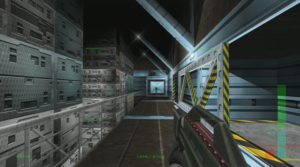 The second level in the set is Rescue. When you start, you quickly reach this corridor; the door this guard protects is locked. However, if you left the technician alive on the previous level, you can use the X-Ray Visor you have for this mission (for an unrelated objective) to look through the door, and sure enough, the technician you kindly saved will be standing behind the
The second level in the set is Rescue. When you start, you quickly reach this corridor; the door this guard protects is locked. However, if you left the technician alive on the previous level, you can use the X-Ray Visor you have for this mission (for an unrelated objective) to look through the door, and sure enough, the technician you kindly saved will be standing behind the  door. After a few moments he will open the door, be terrified by your presence and run away, but his work is done – he opened the door. Once through you find yourself on the upper level of the hangar you were in on the previous level, but this time the lift you arrived in doesn’t transport you between two hangars but instead takes you nearer the surface into an area you would only normally visit in the bonus mission unlocked at the
door. After a few moments he will open the door, be terrified by your presence and run away, but his work is done – he opened the door. Once through you find yourself on the upper level of the hangar you were in on the previous level, but this time the lift you arrived in doesn’t transport you between two hangars but instead takes you nearer the surface into an area you would only normally visit in the bonus mission unlocked at the end of the campaign. On a pedestal in this room you’ll find a Phoenix, a very powerful weapon you don’t normally get until the final few levels. This is an interesting method of placing secrets that FPS games, even those with distinct levels, don’t ordinarily do – your seemingly-trivial side actions on one level have an effect on the next level to unlock a door, or keep an NPC alive, or allow you to use a vehicle (both of those also happen in the game). They are entirely unessential to completing the game. I think this may also be another example of the “dead ends” that Gamespot so disliked, but actually points towards a different issue – that the game expects the player to explore and experiment (and, given the era, to presumably discuss with other players online) to figure out how to open some of these doors. There are far fewer doors in the game that truly “go nowhere” than that article implies; many can be opened by an obscure sequence or link to another part of the map that might be visited on a related mission, or in many cases, a higher difficulty. Towards the end of the level you may come across this locked door, another apparent “dead end”, but it is actually anything but…
end of the campaign. On a pedestal in this room you’ll find a Phoenix, a very powerful weapon you don’t normally get until the final few levels. This is an interesting method of placing secrets that FPS games, even those with distinct levels, don’t ordinarily do – your seemingly-trivial side actions on one level have an effect on the next level to unlock a door, or keep an NPC alive, or allow you to use a vehicle (both of those also happen in the game). They are entirely unessential to completing the game. I think this may also be another example of the “dead ends” that Gamespot so disliked, but actually points towards a different issue – that the game expects the player to explore and experiment (and, given the era, to presumably discuss with other players online) to figure out how to open some of these doors. There are far fewer doors in the game that truly “go nowhere” than that article implies; many can be opened by an obscure sequence or link to another part of the map that might be visited on a related mission, or in many cases, a higher difficulty. Towards the end of the level you may come across this locked door, another apparent “dead end”, but it is actually anything but…
The third level, Escape, returns highlights the inter-connectivity of this level. Just like the first two you visit some new areas of the complex and some of the ones you’ve already been to as well, helping the player build up their mental image of the entire area. At the end of the level you are given two options – to let your ally sacrifice himself so you can escape, or you can help him escape and try and find your own way out. The default is the former; many players are unlikely to even realize the latter is an option (again perhaps contributing to the impression that the level is full of pointless doors?). However, if you offer to let your ally escape and find your own way out, the way in you took in the earlier two missions is locked, so another route must be found.
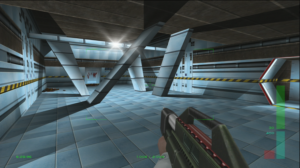 At this point much of the level unlocks (but not the way “backwards”) and you can make your way to the other side of the complex. Whilst guards continue to spawn you will find your way to the door shown above, but this time, it’s unlocked. You pass over a bridge and come to the room on the left, which you won’t have visited before. The door just shown in the right of the
At this point much of the level unlocks (but not the way “backwards”) and you can make your way to the other side of the complex. Whilst guards continue to spawn you will find your way to the door shown above, but this time, it’s unlocked. You pass over a bridge and come to the room on the left, which you won’t have visited before. The door just shown in the right of the 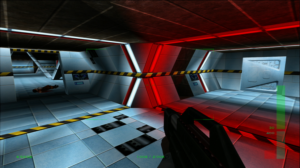 picture leads back to where you met your ally the mission before, whilst the blood-splattered door ahead (blood splatter optional) leads into this room. Seem familiar? This is the other side of the locked door from all the way back in Infiltration! You open the door and you’re back outside, and the moment you step over the threshold, the mission ends, and you’ve gone full circle through the entire Area 51 map, even though it took three different missions to do it.
picture leads back to where you met your ally the mission before, whilst the blood-splattered door ahead (blood splatter optional) leads into this room. Seem familiar? This is the other side of the locked door from all the way back in Infiltration! You open the door and you’re back outside, and the moment you step over the threshold, the mission ends, and you’ve gone full circle through the entire Area 51 map, even though it took three different missions to do it.
Whilst some FPS games have you circle back around in order to explore a new area, few have you do this between levels. Indeed, most modern FPS prefer to have a linear path not just between levels but within levels themselves; games like the Legend of Zelda or Dark Souls may emphasize the opening up of new shortcuts and the like, but it’s rare for an FPS to do the same. Whilst many players will not even figure out that this ending exists, once you do it the entire map comes together rather suddenly in one’s head – you haven’t just been going deeper and deeper into the complex, but rather moving around the complex, and coming back out through the locked door you might have visited in Infiltration is a great moment the first time it happens.
In the picture below you can see the parts of the overall Area 51 map (thanks to memoryhacking.com for the background image; the three coloured outlines are my additions) that are used in each part of the level. Rescue overlaps with Infiltration, Escape overlaps with Rescue, and Infiltration in turn has a little overlap with Rescue. When you choose the “hidden” ending in Escape, much of the Rescue part also unlocks, but that’s only for the “final run” to escape Area 51 on the hoverbike.
Thus, in the entire three levels – despite their complexity – there is not a single door that is not used at some point. Once the player understands that locked doors are not just those doors you get in other games that are textures rather than objects (a la Half-Life 2) but do always lead onto some other part of the level (though I confess there are one or two minor exceptions, but only one or two in the entire game), it becomes apparent that these doors are actually things the player is meant to remember and keep track of. Locked door this time? Well, if the next level takes place on the same map (or parts of it), perhaps it will be open this time? Or maybe there’s some secret sequence that will unlock it and give me access to a secret? Once you realize this, finding a locked door is actually quite an interesting moment as you try to figure out how best it may be opened. I think the criticism over dead-ends shows a lack of appreciation of both the complexity of some of the maps, and (as I’ll talk about next) the fact that some parts of some maps are only unlocked on higher difficulties, or if you perform a particular (sometimes quite obscure) action within the mission.
Deep Sea: Nullify Threat
On higher difficulty levels these days we rarely see FPS games that put forward more objectives. You still go to the same places on the same levels and do the same things, but it’s just “harder” – enemies have more health, more accuracy, better weapons, fire faster, smarter AI, etc. However, Perfect Dark often has areas of its levels which either require a particular difficulty setting or a particular trigger to access. An amazing example of this is the Deep Sea level. During this mission you have to “disable a megaweapon” on a sunken alien vessel, but depending on which difficulty you play on, you will visit three totally different maps and disable the weapon in three totally different ways. If you never do all three difficulty levels you will never even see some parts of this level (and even if you DO play it on the highest difficulty, some parts of the level can only be sighted using the see-through-walls scope on one of the weapons, and cannot be physically accessed). This takes both the non-linearity and the emphasis on new areas and new objectives for higher difficulties to a higher point than any other mission.
 On Agent difficulty you find your way through a series of corridors into the room on the right, illuminated by a pulsing green light. In this first example you wait until your ally catches up with you (which can take a while as he loves wasting time on the path there) and wait until he disables the weapon by using the console. Although you only see this area on Agent, it’s a surprisingly atmospheric room (and hints towards just how many rooms in the later Timesplitters series would have pulsing lights).
On Agent difficulty you find your way through a series of corridors into the room on the right, illuminated by a pulsing green light. In this first example you wait until your ally catches up with you (which can take a while as he loves wasting time on the path there) and wait until he disables the weapon by using the console. Although you only see this area on Agent, it’s a surprisingly atmospheric room (and hints towards just how many rooms in the later Timesplitters series would have pulsing lights).
 On Secret Agent the same teleporter takes you instead to a balcony overlooking this room which you quickly descend towards down a spiraling corridor. Whereas the first appears to be a control room, this appears to be perhaps the firing mechanism of the weapon itself? The second beam feeding into the middle has to me always evoked the little ignition fire on a flamethrower; as something small that triggers the far greater weapon. Although you’re now clearly near the core or the firing mechanism of the weapon itself, your ally is still required to disable it.
On Secret Agent the same teleporter takes you instead to a balcony overlooking this room which you quickly descend towards down a spiraling corridor. Whereas the first appears to be a control room, this appears to be perhaps the firing mechanism of the weapon itself? The second beam feeding into the middle has to me always evoked the little ignition fire on a flamethrower; as something small that triggers the far greater weapon. Although you’re now clearly near the core or the firing mechanism of the weapon itself, your ally is still required to disable it.
 Having seen the control room and the firing mechanism of the weapon on the other two difficulties, on the Perfect Agent difficulty you pass through a series of rooms that seem to form the power supply of the weapon. In these you have to destroy these glowing pillars, before then doing something very interesting. You’ve been equipped with a weapon that can see
Having seen the control room and the firing mechanism of the weapon on the other two difficulties, on the Perfect Agent difficulty you pass through a series of rooms that seem to form the power supply of the weapon. In these you have to destroy these glowing pillars, before then doing something very interesting. You’ve been equipped with a weapon that can see  through walls and you have to use it in order to shoot out the final few pillars which cannot be accessed or seen ordinarily. That these final components cannot be easily reached – combined with the fact that stopping the megaweapon on this difficulty needs destruction instead of a technical fix, reinforces the sense that you’re crawling around the least accessible parts of the ship; its engineering decks, engines, fuel reserves, power supplies, and so forth. The fact you visit a different part of the ship on each difficulty makes this one of my favorite levels in the game – the “higher difficulty areas” are larger than any other level, more varied, and although nothing explicit is said the aesthetics of the three areas seem to suggest the three different “components” of the weapon I’ve described here. I also (this will be a common theme for regular readers) also really appreciate the effort put in to what could easily be termed “optional content” – a lot of players will never see some of these areas, but they still took the time to put them in, and it really rewards you for attempting the higher difficulty levels.
through walls and you have to use it in order to shoot out the final few pillars which cannot be accessed or seen ordinarily. That these final components cannot be easily reached – combined with the fact that stopping the megaweapon on this difficulty needs destruction instead of a technical fix, reinforces the sense that you’re crawling around the least accessible parts of the ship; its engineering decks, engines, fuel reserves, power supplies, and so forth. The fact you visit a different part of the ship on each difficulty makes this one of my favorite levels in the game – the “higher difficulty areas” are larger than any other level, more varied, and although nothing explicit is said the aesthetics of the three areas seem to suggest the three different “components” of the weapon I’ve described here. I also (this will be a common theme for regular readers) also really appreciate the effort put in to what could easily be termed “optional content” – a lot of players will never see some of these areas, but they still took the time to put them in, and it really rewards you for attempting the higher difficulty levels.
Carrington Institute: Defence
This is the last level I want to look at. It takes place directly after Deep Sea and I think the setting of this level is interesting (the other two levels having illustrated my thoughts on the level design of Perfect Dark). Until you reach this point in the game, the “Carrington Institute” is your home-base or your hub, akin to Firelink in Dark Souls, the Normandy in Mass Effect or Monteriggioni in Assassin’s Creed 2. You can leave the campaign at any time to come back here and wander around, explore the institute, talk to any of the staff, do a bunch of tests (which range from the challenging and enjoyable like the firing range to the… less challenging and less enjoyable like a lot of the equipment tasks), read up on information on the plot, weapons, locations, vehicles and whatever else, and generally take a break. Back when I played on the N64 I found it surprisingly easy to just wander around here and take a break from the missions themselves; it becomes a place of easy relaxation and safety.
 Which is why (much like Mass Effect & Assassin’s Creed: Brotherhood would do a decade later) it’s so very, very clever when one of the later missions has you defending the institute and rescuing the hostages who are these people you’ve been chatting with and helping out up to this point. In these two screenshots, the folks in green are your friends, the blue/black guards the invaders holding them
Which is why (much like Mass Effect & Assassin’s Creed: Brotherhood would do a decade later) it’s so very, very clever when one of the later missions has you defending the institute and rescuing the hostages who are these people you’ve been chatting with and helping out up to this point. In these two screenshots, the folks in green are your friends, the blue/black guards the invaders holding them  hostage; you have to leap into the offices and gun down both the hostage takers within a second or two before they take out your friends. It’s a very effective technique; whilst I enjoy a lot of other missions, this one has always felt to me the most urgent and the most “real”, somehow, as your enemy invades the place you’ve been comfortable wandering around and calling home between missions. It’s a surprisingly effective technique, and whilst I don’t know if Perfect Dark was the first game to ever give you a hub which is later explicitly attacked, it is certainly chronologically the first I know of. Whilst this isn’t strictly a level design observation, when one plays the Defence mission one then realizes that, actually, the Institute has been designed to offer an interesting singleplayer mission as well as being a believable hub for the rest of the game.
hostage; you have to leap into the offices and gun down both the hostage takers within a second or two before they take out your friends. It’s a very effective technique; whilst I enjoy a lot of other missions, this one has always felt to me the most urgent and the most “real”, somehow, as your enemy invades the place you’ve been comfortable wandering around and calling home between missions. It’s a surprisingly effective technique, and whilst I don’t know if Perfect Dark was the first game to ever give you a hub which is later explicitly attacked, it is certainly chronologically the first I know of. Whilst this isn’t strictly a level design observation, when one plays the Defence mission one then realizes that, actually, the Institute has been designed to offer an interesting singleplayer mission as well as being a believable hub for the rest of the game.
Changing FPS Standards?
Now, let’s look at a comment from Eurogamer.
Perfect Dark’s not afraid to throw dead ends at you seemingly for the hell of it, or repeat textures so much in its huge maps that you can get a little dizzy.
I think we have covered the first half of that comment – that these locked doors are either for other levels using the same map, or for higher difficulties on the same map – but let’s consider the repeating of textures. This, alas, is somewhere Perfect Dark does fall down, but at the same time it tries (sometimes) to negate the most negative effects of the copy-paste level construction that raises its head in a few places. Several levels can be confusing until you come to know them. For all I praised the interesting design and the secrets of the Area 51 levels above, when you first play them (especially during Rescue) it can be hard to orient yourself inside in the endless sequence of similar pristine corridors. However, the game does offer something to help – there’s a range of different door shapes only used in a small number of places. Whether these were specifically placed to help people orient themselves is, perhaps, besides the point – once you come to recognize the various types of doors, the similar-looking corridors stop blurring into one another. Whilst I cannot confirm this, why have so many different types of door otherwise? Why go to the effort of having different sizes, different textures, different animations, some with/without glass, if this variation didn’t serve some purpose to help the player orient themselves?
Since (as we’ve covered) the levels are rarely straight lines, this makes the need for the player to get their orientation even more important. If the levels were just straight lines like The Library in Halo CE, for example, dull or repeating textures are never an issue since you never get turned around. The Perfect Dark levels are rarely straight lines, make no mistake, but as above they do at least try a lot of other things to signpost your way which just require a little more attention. For example, DataDyne : Research (the second mission) could be seen as a maze of similar corridors and identical doors, and as a young teenager playing the game on the N64 I found it unclear at times how to progress. However, the game subtly points you in the right direction; the mission briefing mentions you need to head towards Sector 4, the “highest” sector, and sure enough you start seeing doors with Sector X markings on them, helping you mark your progress through the level. If you didn’t read the briefings, though, perhaps you wouldn’t assign much significance to these visual markers?
Equally, consider the level Pelagic II. Even now I sometimes get confused on this level, but they at least tried to help the player find their way around by changing the colours of the lighting on each floor; the lowest floor is blue, the first floor (where you start) is red, then yellow and green at the top. Once you figure this out it aids you greatly in figuring out which part of the ship you’re in.
Every level that suffers from this problem does try to do something to alleviate it and help the player get their bearings, but it’s debatable how much use the Pelagic II’s different colours are when, even though there are four colours, there are a dozen identical corridors in each colour. In this regard, I believe the second half of the criticism many reviewers isolated – the reuse of textures – is a legitimate one on some levels of the game, even if some of these tried their best to cancel it out. To alleviate this problem a designer has two possible solutions – either make levels much more distinct throughout (like many PD levels are) so that you can easily distinguish between the different regions of the level, or make the levels so linear that you cannot possibly go wrong.
The sad truth, I think, is that contemporary FPS games have done both. They’ve sacrificed the complexity and many-layered levels in order to make things clearer, but they’ve also sacrificed the subtle things that point you in the right direction. The path forward is obvious, but that no longer matters when there’s only one path you could take anyway! You could preserve the complex levels whilst adding more signs and symbols where you need them, or lose the complex levels and not have to do any more effort in laying out the path, but many modern FPS games seem to have done both. In their Perfect Dark review, Joystiq acknowledged that:
“Love it or hate it, modern games have us weaned on hour-long tutorials and overzealous narrators who explain every detail to us ad nauseam. So, when you jump into an older game like Perfect Dark, you’ll be surprised at how self-sufficient you’re asked to be. “
And I think this says it all. It came with some downsides – getting lost on the Pelagic II research ship is an infuriating experience that everyone should experience at least once in their lives – but at the same time we’ve sacrificed the completeness of Area 51 and the many “hidden” areas of the sunken alien vessel in Deep Sea. Modern FPS games have perhaps gone too far by taking both solutions to the issue when only one solution was really needed, along with other structural questions – what counts as a “mission”, for example? – that are questions for another day. Ultimately, if you want an FPS world that has more of an exploration focus than most these days do, give that XBLA version a download – you won’t be patronized by the game, you can explore some of the surprisingly “complete” and convincing levels the game has to offer which often really do feel like part of a cohesive world, and you certainly won’t be disappointed.
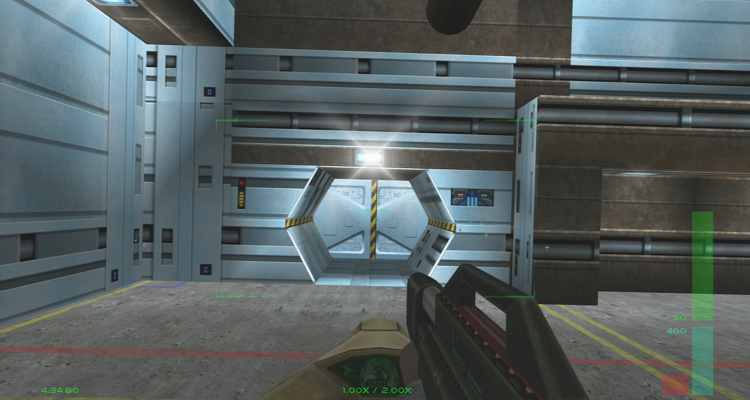
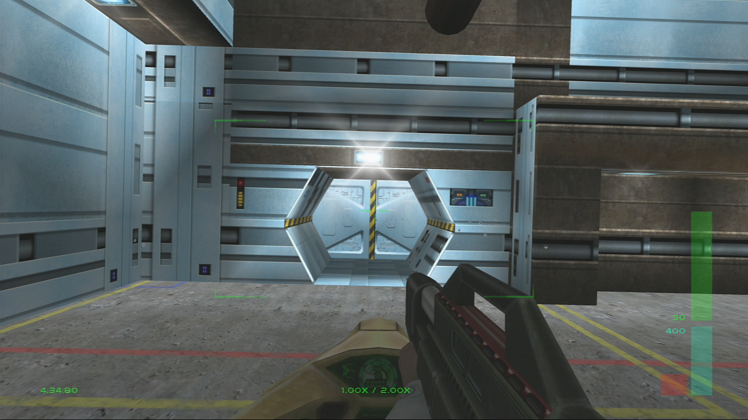
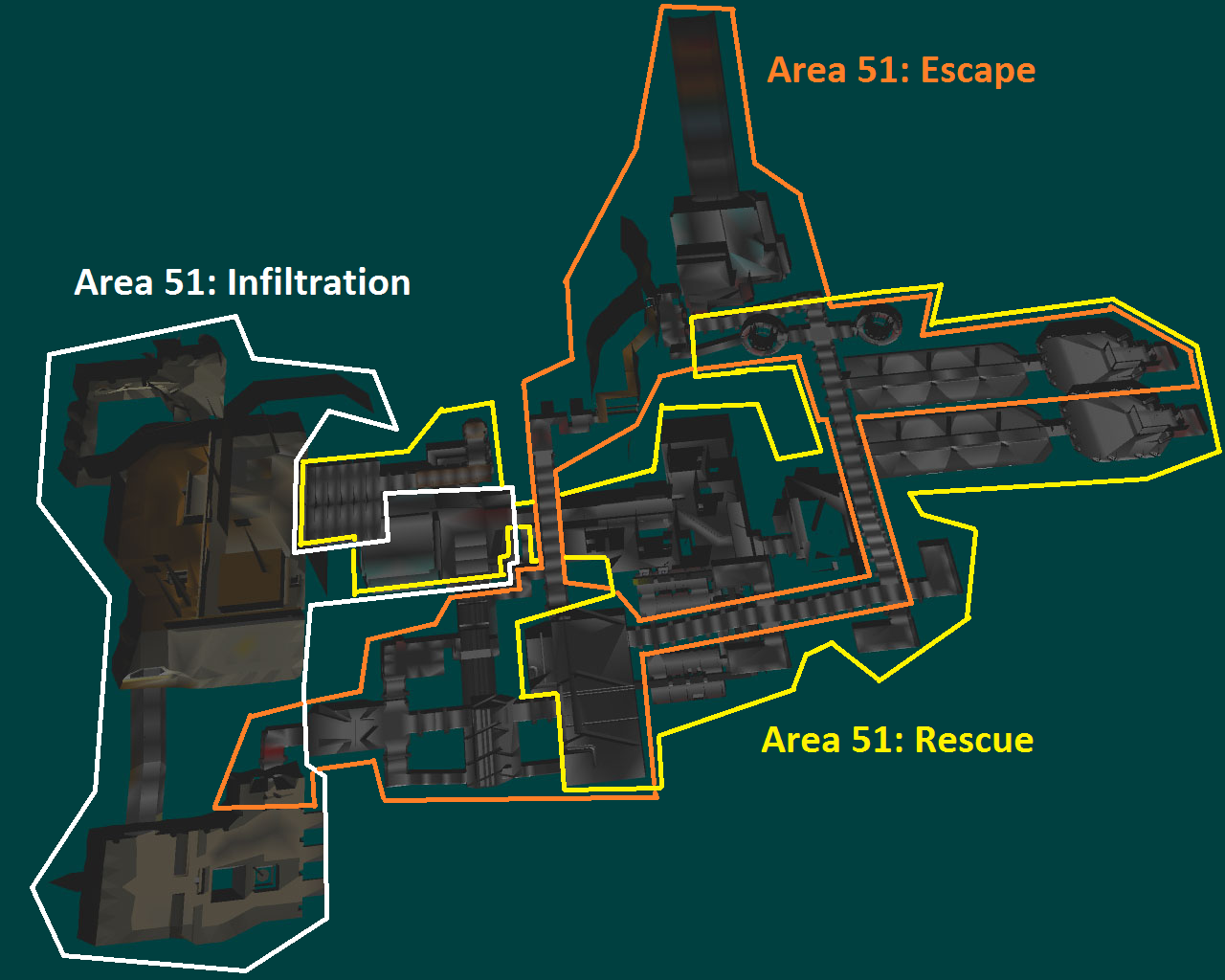
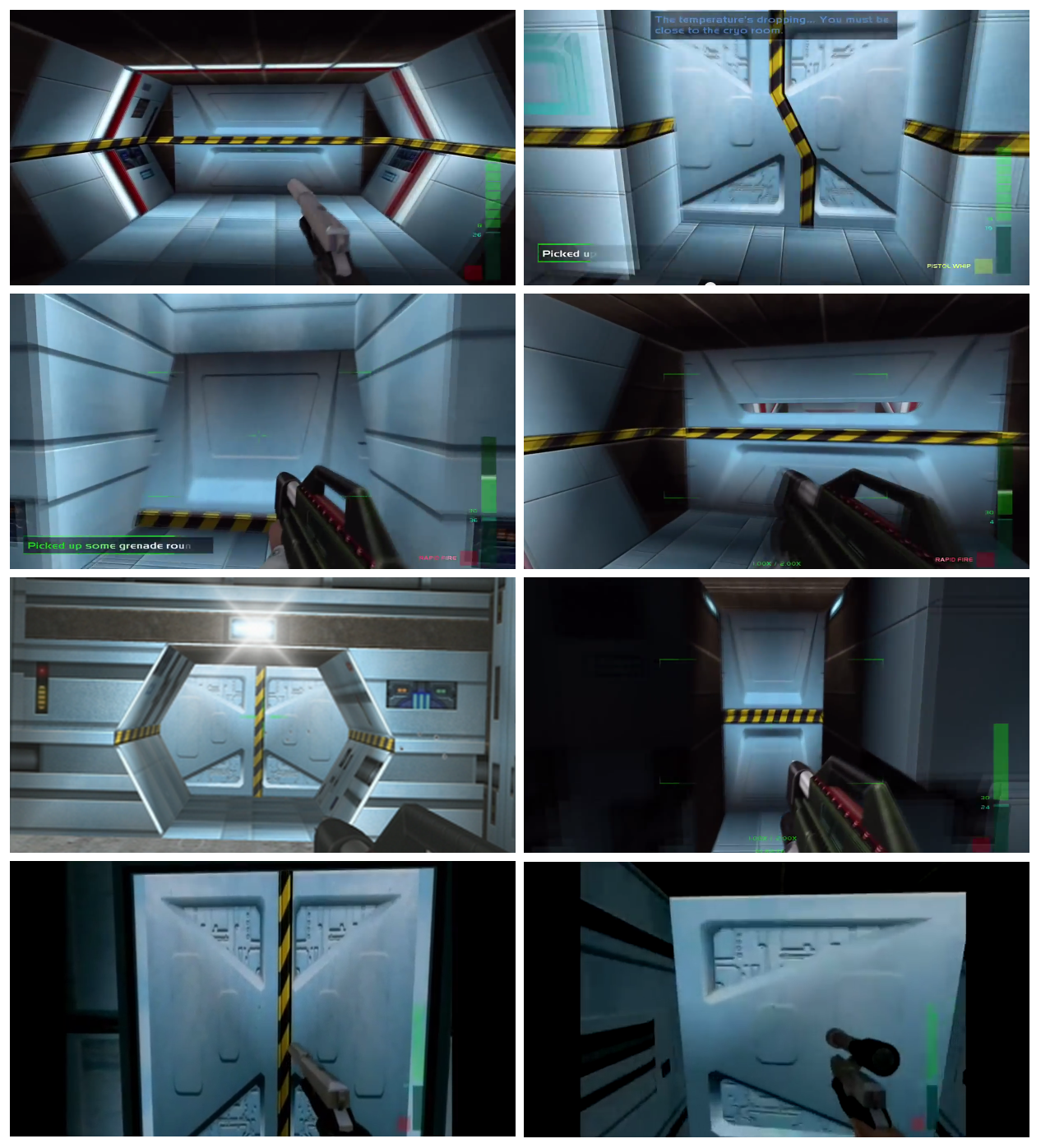

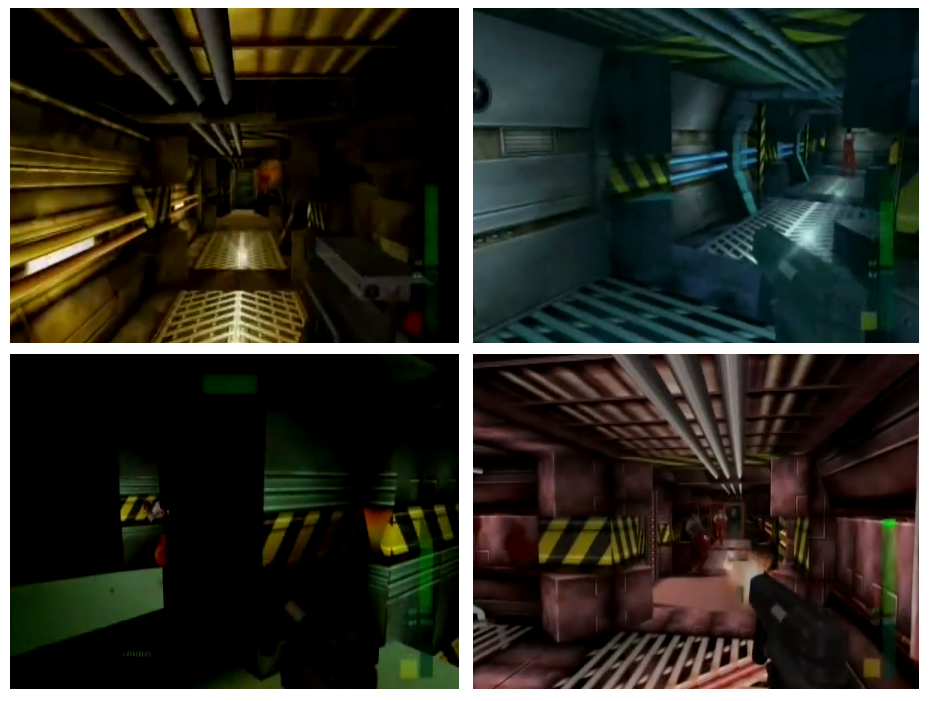
The criticism of those stating the game misses markers and navigational arrows and such and would be almost unplayable just shows one thing — the „modern” gamer does not think, he just obeys and relies on illogical and even stupid chaining of events which suddenly gives him all necessary things without having to work for them in a fun, entertaining way. As a classical gamer who started playing video and computer games in the early 1980’s, I am used to games which made you think for yourself, eg. find your way through a maze or city or whatever without a pointing arrow and a hovering „quest marker” (RPGs, tacticals, ego shooters) by looking for hints and talking to people (if there are any), to look around and ask around to get information and required things (tacticals, ego-shooters, RPGs, adventures) instead of suddenly having all information and just needing to go there and getting it or pushing a massively oversized button (or acting on a hologram-style marker which says „do it here”) to achieve the mission (sub)goal. In my opinion, modern „gaming” has no gaming fun at all anymore, due to those „don’t think, just follow the arrows” and „hack, shoot and slay anything in your way” approaches.
That is exactly why I stopped playing „modern” games somewhere around 2010 – they bored me to death, partly because most of today’s games do not last longer than three to twelve hours in total game play, and replaced intriguing immersion with stupid repetition, senseless destruction and violence, immersion-breaking „simplified” methods of information gathering and equipment buying/selling/repairing, and „guidance” to the point of the player being treated like a stupid moron who cannot even bind his own shoe-laces or find his way to the kitchen without a talking map and an augmented reality guidance system using holograms. In addition, many action sequences or action-based games are scripted to a point which makes me think „they cannot mean this seriously if they want to enforce this stupid subplot” because it takes away every chance to play the way I want to play the situation and forces me into dumb hollywood style or illogical follow-up situations.
I can only strongly advise ALL people who think of themselves as experienced players to get and play not only Perfect Dark, but also the following games (eg. from Amazon or Steam or abandonware sites) – you might first think they are ugly and ancient and unplayable, but they are in fact entertaining for years, and show you what you are missing in all of today’s games. They will show you that you aren’t, because you un-learned the most important things: to think for yourselves, and to have fun.
– Tomb Raider (the original EIDOS game from 1996)
– The Elder Scrolls III: Morrowind
– System Shock
– System Shock 2
– Deus Ex
– Ultima Underworld: The Stygian Abyss
– Wasteland (the Interplay original from 1988, NOT the newer game)
– Outcast
– Heavy Metal: F.A.K.K.²
– Project Eden
Old post, but I’m replaying Perfect Dark recently, almost through on Special Agent now, and made this same realization and wanted to search the web for the combined Area 51 map (and the Crash Site map which i also realized is more connected than before). My most recent playthrough was…. idk 15 years ago and still have some memory of it on Perfect Agent which led me astray a few times here!
I think it is all nice design, I like the maps, the objectives, the difficulty ramp. Deep Sea is my least favorite level in the game but your way of looking at it makes it a bit cooler to me too! (so btw, I got stuck on it for a few minutes again because the area to reactivate those teleportals got me a bit lost on Agent. Found it much easier on Special Agent – perhaps because I was refreshed on the layout again, but I actually think the closed doors helped a lot. The closed doors stood out and pointed forward instead of getting circled around in the dark like happened to me on Agent.)
There’s so many nice little connections across the levels in this game. And my favorite part? The levels – and the game as a whole really – are (mostly) short enough that replaying them doesn’t feel like a huge commitment. I don’t have the same kind of free time I used to lol.
Anyway I wanted to say I appreciate this post, thanks for writing it.
Hello adr, thanks so much for the comment! Deep Sea is definitely a confusing level; I struggled as a kid and a teen, but increasingly, like you, I like it a lot more as time goes by. And you’re right, the levels have enough to feel involved and meaningful, but they’re also not tremendous epics like, say, a Halo level. I haven’t played it in a long time either, though the game remains an all-time favourite for me. I honestly think it’s just fabulous, there’s so much to it and so much love and care put into its design.
Thanks again for the feedback though, I’m so glad you enjoyed the post!